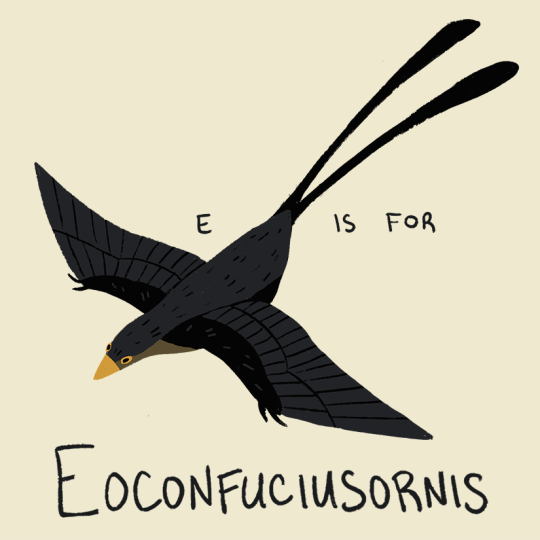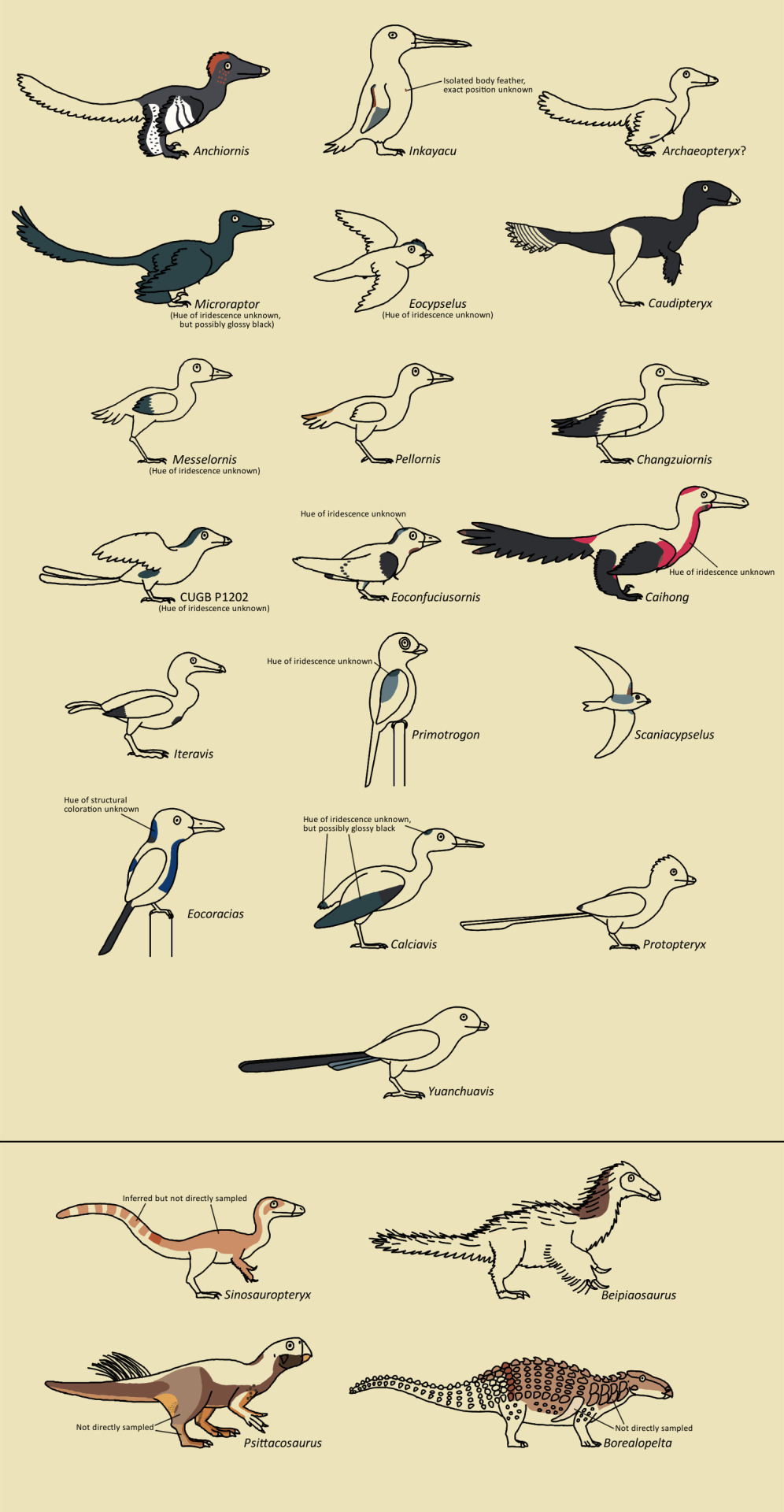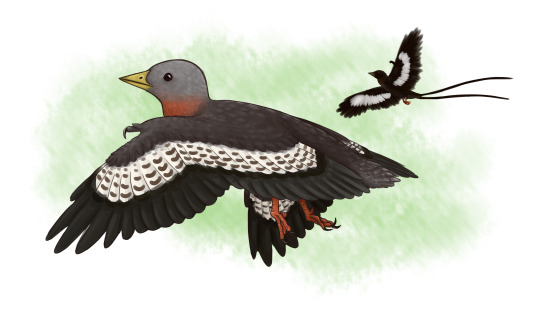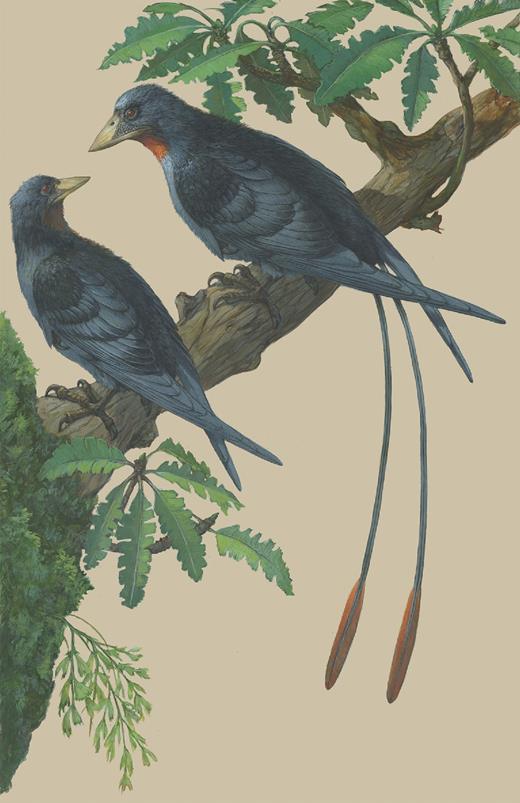#Eoconfuciusornis
Text





The Maniraptoran Alphabet (Part 1)
This past week I researched and illustrated a dinosaur alphabet book! I researched and illustrated 26 maniraptorans for the project, specifically limiting myself to species that went extinct before the Eocene to exclude modern birds. This project was a huge amount of fun for me and I'm very proud of the result, so I hope you all enjoy them too! Please look forward to the rest of the series, which I'll be posting over the course of the coming week or so.
#dinosaur#maniraptoran#dromaeosaurid#troodontid#therizinosaurid#avialae#anchiornis#beipiaosaurus#caihong#deinonychus#eoconfuciusornis#confuciusornis#paleoart#alphabet#illustration#artaneae#it would have been very easy to make this all dromaeosaurs with like 1 or 2 oviraptorids to fill in letters#but I think I managed to avoid that#no promises that these are 100% accurate due to the stylization and the fact that I did 26 of these within a week but I did my best
239 notes
·
View notes
Text
I paleontologi trovano il fossile di un uccello col becco di 119 milioni di anni fa
I paleontologi trovano il fossile di un uccello col becco di 119 milioni di anni fa
Ricostruzione dell’uccello confuciusornitiforme Eoconfuciusornis zhengi del primo Cretaceo.
Una nuova specie di uccello confuciusornitide, denominata Confuciusornis shifan, è stata identificata da uno scheletro quasi completo rinvenuto nella Cina nordorientale.
Confuciusornis shifan visse nell’attuale Cina durante il primo Cretaceo, circa 119 milioni di anni fa.
La nuova specie apparteneva a…

View On WordPress
0 notes
Photo

In the wake of 2021, added Yuanchuavis and modified Eoconfuciusornis for the paleocolor chart.
More detailed description
#Palaeoblr#Birblr#Dinosaurs#Birds#Feathered dinosaurs#Anchiornis#Inkayacu#Archaeopteryx#Microraptor#Eocypselus#Caudipteryx#Messelornis#Pellornis#Changzuiornis#Eoconfuciusornis#Caihong#Iteravis#Primotrogon#Scaniacypselus#Eocoracias#Calciavis#Protopteryx#Yuanchuavis#Sinosauropteryx#Beipiaosaurus#Psittacosaurus#Borealopelta
668 notes
·
View notes
Text
Eoconfuciusornis zhengi

By Scott Reid on @drawingwithdinosaurs
PLEASE SUPPORT US ON PATREON. EACH and EVERY DONATION helps to keep this blog running! Any amount, even ONE DOLLAR is APPRECIATED! IF YOU ENJOY THIS CONTENT, please CONSIDER DONATING!
Name: Eoconfuciusornis zhengi
Name Meaning: Dawn Confucius Bird
First Described: 2008
Described By: Zhang, Zhou & Benton
Classification: Dinosauria, Theropoda, Neotheropoda, Averostra, Tetanurae, Orionides, Avetheropoda, Coelurosauria, Tyrannoraptora, Maniraptoriformes, Maniraptora, Pennaraptora, Paraves, Eumaniraptora, Averaptora, Avialae, Euavialae, Avebrevicauda, Pygostylia, Confuciusornithiformes
Eoconfuciusornis is an Avialan that lived about 131 million years ago, in the Haquterivian age of the Early Cretaceous - making it older than Confuciusornis, its relative, leading to its name. It had a pointed, toothless snout, but this snout was probably not homologous (meaning, having the same evolutionary origin) as modern bird beaks, given that many birds more derived than Eoconfuciusornis retained teeth. It is, however, the oldest known Avialan to have a beak. It is from the Dabeigou Formation in Hebei Province, China, and it is known multiple fairly complete skeletons, including a female in the early process of generating new eggs. Eoconfuciusornis was smaller than Confuciusornis, and it had longer legs and lacked a crest on the humerus, unlike Confuciusornis.

By Michael Rothman, taken from Zheng et al. 2017.
It is the most early derived member of the Confuciusornis family group (which is called Confuciusornithidae or Confuicusornithiformes, depending on the context, so I’m just going to keep calling it the family group.) It had a triangular head, and pointed but broad wings, indicated it was well built for gliding, as well as ribbon tail feathers that would probably have been used for display, seeing as they were sexually dimorphic. Some coloration is known from the fossil female, which does not preserve the ribbon feathers (indicating the aforementioned sexual dimorphism); it’s difficult to completely construct the coloring, but the females were probably mostly black, with a brown throat patch, grey head and legs, and darkly spotted wings.
Source:
https://en.wikipedia.org/wiki/Eoconfuciusornis
Martyniuk, M. P. 2012. A Field Guide to Mesozoic Birds and other Winged Dinosaurs. Pan Aves; Vernon, New Jersey.
Zheng, X., J. K. O’Connor, X. Wang, Y. Pan, Y. Wang, M. Wang, Z. Zhou. 2017. Exceptional preservation of soft tissue in a new specimen of Eoconfuciusornis and its biological implications.
Shout out goes to @jamieraptor!
#eoconfuciusornis#eoconfuciusornis zhengi#dinosaur#bird#palaeoblr#birblr#jamieraptor#paleontology#prehistory#prehistoric life#dinosaurs#biology#a dinosaur a day#a-dinosaur-a-day#dinosaur of the day#dinosaur-of-the-day#science#nature#factfile#Dìneasar#דינוזאור#डायनासोर#ديناصور#ডাইনোসর#risaeðla#ڈایناسور#deinosor#恐龍#恐龙#динозавр
94 notes
·
View notes
Photo

New spectacular specimen of the early bird Eoconfuciusornis from the Early Cretaceous lake deposits in Hebei, northern China.
The unique preservation of melanosomes in the fossil feathers of this specimen allowed Chinese researchers to detect, for the first time, evidence of the molecule beta-keratin. The identification of melanosomes in feathered fossils has been somewhat controversial, as some argue that the microstructures could in fact be fossilized bacteria. The presence of beta-keratin, among other lines of evidence, seem to confirm they are indeed the remnants of melanosomes. The distribution of melanosomes is also consistent with modern feathers.
12 notes
·
View notes
Text
Exceptional fossils of Cretaceous bird Eoconfuciusornis reveal coloration, soft-tissue anatomy, and sexual dimorphism
Original post | Reddit thread
3 notes
·
View notes
Photo

Exceptional fossils of Cretaceous bird Eoconfuciusornis reveal coloration, soft-tissue anatomy, and sexual dimorphism via rddit science http://ift.tt/2nRCr0W
0 notes
Text
Scientists make new discovery about bird evolution
A team of scientists has described the most exceptionally preserved fossil bird discovered to date, in a newly published article. The new specimen from the rich Early Cretaceous Jehol Biota (approximately 131 to 120 million years old) is referred to as Eoconfuciusornis, the oldest and most primitive member of the Confuciusornithiformes, a group of early birds characterized by the first occurrence of an avian beak.
0 notes
Text
Scientists make new discovery about bird evolution
Scientists make new discovery about bird evolution
A team of scientists has described the most exceptionally preserved fossil bird discovered to date, in a newly published article. The new specimen from the rich Early Cretaceous Jehol Biota (approximately 131 to 120 million years old) is referred to as Eoconfuciusornis, the oldest and most primitive member of the Confuciusornithiformes, a group of early birds characterized by the first occurrence…
View On WordPress
0 notes
Text
Scientists make new discovery about bird evolution
Scientists make new discovery about bird evolution
A team of scientists has described the most exceptionally preserved fossil bird discovered to date, in a newly published article. The new specimen from the rich Early Cretaceous Jehol Biota (approximately 131 to 120 million years old) is referred to as Eoconfuciusornis, the oldest and most primitive member of the Confuciusornithiformes, a group of early birds characterized by the first occurrence…
View On WordPress
0 notes
Text
Scientists make new discovery about bird evolution
A team of scientists has described the most exceptionally preserved fossil bird discovered to date, in a newly published article. The new specimen from the rich Early Cretaceous Jehol Biota (approximately 131 to 120 million years old) is referred to as Eoconfuciusornis, the oldest and most primitive member of the Confuciusornithiformes, a group of early birds characterized by the first occurrence of an avian beak.
Latest Science News -- ScienceDaily https://www.sciencedaily.com/releases/2017/03/170324192645.htm
0 notes
Text
I ricercatori pongono vincoli di età sull'aspetto e sulla durata del Jehol biota
I ricercatori pongono vincoli di età sull’aspetto e sulla durata del Jehol biota


Mappa di restauro ecologico del Jeho Biota (A) e un esemplare rappresentativo di fossile di Eoconfuciusornis con piuma eccezionalmente conservata (B).
Il Jehol biota1 è ben noto per la produzione di esemplari eccezionalmente ben conservati di dinosauri pennuti, uccelli primitivi, mammiferi, così come di insetti e piante a fioritura precoce.
Tuttavia, la mancanza di precisi vincoli di…
View On WordPress
0 notes
Photo

Updated my dinosaur paleocolor lineup with a few new entries from 2020: the lithornithid Calciavis (glossy black plumage) and the enantiornithean Protopteryx (black wingtips).
More detailed description
#Palaeoblr#Birblr#Dinosaurs#Birds#Feathered dinosaurs#Anchiornis#Inkayacu#Archaeopteryx#Microraptor#Eocypselus#Caudipteryx#Messelornis#Pellornis#Changzuiornis#Eoconfuciusornis#Caihong#Iteravis#Primotrogon#Scaniacypselus#Eocoracias#Calciavis#Protopteryx#Sinosauropteryx#Beipiaosaurus#Psittacosaurus#Borealopelta
79 notes
·
View notes
Photo

The latest in dinosaur paleocolor! 2019 gave us the colors of Eocoracias, and Pellornis gets retroactively added after a previously unnamed specimen was assigned to it.
More detailed description
#Dinosaurs#Birds#Palaeoblr#Birblr#Feathered dinosaurs#Anchiornis#Inkayacu#Archaeopteryx#Microraptor#Eocypselus#Caudipteryx#Messelornis#Pellornis#Changzuiornis#Eoconfuciusornis#Caihong#Iteravis#Primotrogon#Scaniacypselus#Eocoracias#Sinosauropteryx#Beipiaosaurus#Psittacosaurus#Borealopelta
46 notes
·
View notes
Photo

2018 was a good year for the study of paleo-color, adding four species to the line-up of fossil dinosaurs with inferred coloration!
#Dinosaurs#Palaeoblr#Birds#Birblr#Feathered dinosaurs#Anchiornis#Inkayacu#Archaeopteryx#Microraptor#Eocypselus#Caudipteryx#Messelornis#Changzuiornis#Eoconfuciusornis#Caihong#Iteravis#Primotrogon#Scaniacypselus#Sinosauropteryx#Beipiaosaurus#Psittacosaurus#Borealopelta
816 notes
·
View notes
Photo

Confuciusornithiforms were a group of toothless, flying dinosaurs that lived in eastern Asia during the Early Cretaceous. They were similar to modern birds in some ways, but in other ways not quite.
Full view
#Birds#Dinosaurs#Palaeoblr#Confuciusornithiforms#Confuciusornis#Eoconfuciusornis#Changchengornis#Yangavis
29 notes
·
View notes